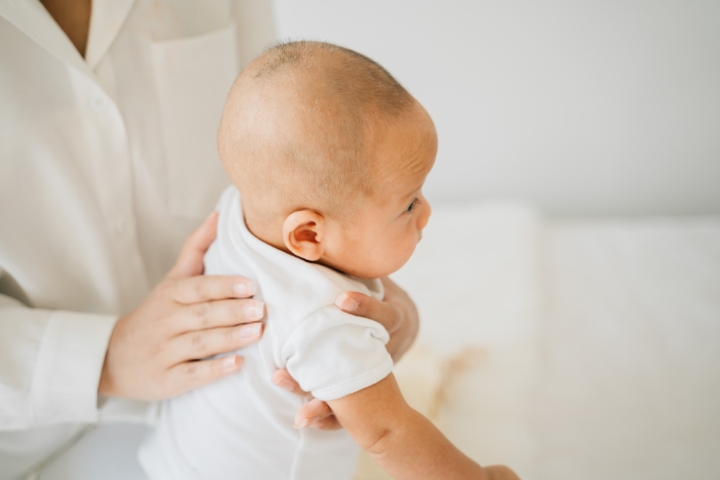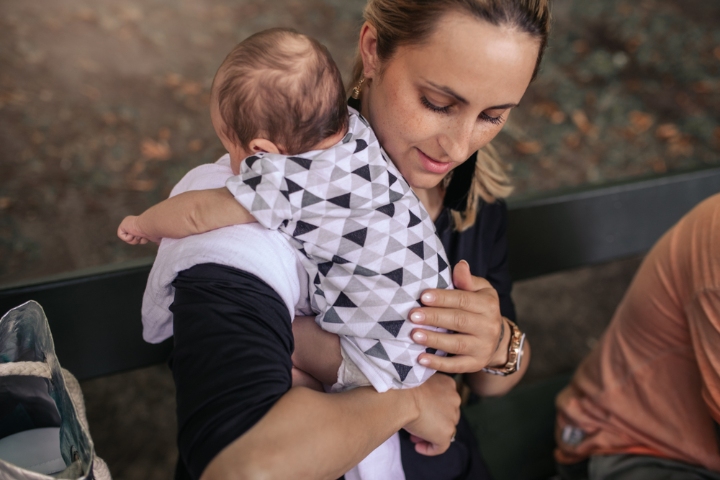
Image: Shutterstock
Mastering the art of burping your child is crucial for parents. It releases trapped air from the baby’s stomach, providing relief while reducing the chances of discomfort, spit-up, and colic. In this comprehensive article, we’ll explore the benefits of burping, different techniques, and ideal moments to burp your baby. Let’s embark on this nurturing journey together!
Why Burping A Baby Is Beneficial
Image: Shutterstock
Burping your baby is important for several reasons.
- Firstly, during feeding, babies tend to swallow air along with breast milk or formula. This trapped air can cause discomfort, bloating, and even hurt their tiny tummies. Burping helps to release this trapped air, providing immediate relief and preventing potential discomfort.
- Secondly, burping helps to reduce the chances of spit-up or reflux. When air bubbles are trapped in the stomach, they can push the milk or formula back up, leading to spit-up. Burping helps to minimize this by expelling the air before it causes any issues.
- Lastly, some babies may experience colic, which is characterized by excessive crying and fussiness. Burping can help alleviate colic symptoms by reducing the amount of air in the baby’s stomach.
How To Burp A Baby
Image: Shutterstock
There are several techniques you can try to burp your baby. Here are three commonly used methods:
1. Over-The-Shoulder Method
Hold your baby upright with their chin resting on your shoulder. Support their head and neck with one hand while using the other hand to gently pat or rub their back. Make sure to do this with a gentle and rhythmic motion to encourage burping.
2. Sitting On Your Lap Method
Sit your baby on your lap facing away from you, with their back resting against your chest. Support their chin and chest with one hand and use the other hand to pat or rub their back in an upward motion. This position allows the baby’s body to lean forward slightly, facilitating the release of trapped air.
3. Face-Down On Your Lap Method
Lay your baby face-down across your lap, with their head turned to the side. Support their head and ensure that their body is slightly elevated. Use one hand to support their chest and chin while gently patting or rubbing their back with the other hand. This position helps to put gentle pressure on the baby’s belly, aiding in the release of gas.
Experiment with these techniques to find what works best for you and your baby. Remember, every baby is unique, so be patient and attentive to their cues during the burping process.
When To Burp Your Baby
Image: Shutterstock
It is generally recommended to burp your baby during and after each feeding. This includes both breastfeeding and bottle-feeding. For breastfeeding, you can burp your baby when you switch breasts or halfway through a longer feeding session. For bottle-feeding, burping can be done every halfway through the feeding. However, keep in mind that some babies may not always need to burp after every feeding. Pay attention to their cues and signs of discomfort, and adjust accordingly.
When To Stop Burping Your Baby
Image: Shutterstock
As your baby grows, their need for frequent burping decreases. Typically, between 4 to 6 months of age, you can start gradually reducing the frequency of burping. It’s important to consult with your pediatrician for guidance on when to stop burping, as each baby develops at their own pace. They can offer personalized advice based on your baby’s individual needs and progress.
Tips For Successful Burping
Image: Shutterstock
Here are a few additional tips to ensure successful burping:
1. Keep Your Baby Upright
Maintain an upright position for your baby during feedings and burping. This helps prevent excessive swallowing of air.
2. Take Breaks During Feedings
Pause occasionally during feedings to give your baby a chance to burp. This can help prevent excessive air intake.
3. Gentle Patting And Rubbing
Use a gentle and rhythmic patting or rubbing motion on your baby’s back to stimulate burping. Avoid excessive force or vigorous movements that may cause discomfort.
4. Stay Prepared
Keep a burp cloth or bib handy during feeding sessions to catch any spit-up or drool that may occur during or after burping.
Mastering the skill of burping is an important task for every parent. By burping your baby, you provide them relief from trapped air in their stomach, reducing the chances of discomfort, spit-up, and colic. It’s beneficial to try different burping techniques to find the one that works best for your little one, and remember to burp them during and after feedings. As your baby grows, they will likely require less frequent burping, and eventually, you can gradually phase it out. Stay attentive to your baby’s cues and consult with your pediatrician for personalized guidance along the way. With practice and care, you’ll become confident in burping your baby, ensuring their comfort and well-being. Let us know in the comments how you burp your baby!

















